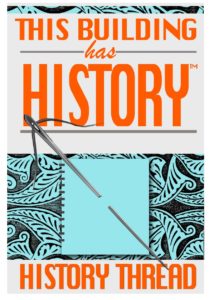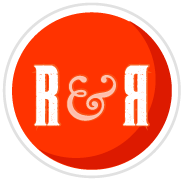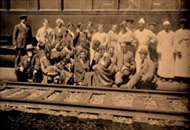The Yorkville Enquirer reported on Jan. 5, 1871 – “A new bank has been organized in Columbia under the name of Central National Bank. The Pres. is Col. J.B. Palmer, cashier is Mr. A.G. Brenizer, and the Ass. Cashier is C.N.G. Butt.”
City Directories and History: (Central National Bank) Built in Second Empire design, the Sylvan Building features a mansard roof covered with slate. The Sylvan Building is architecturally significant as one of the few undamaged examples of this type and period architecture in Columbia. Because of its rarity of type within the area, it is of extreme importance in local architectural history, perhaps the most important building on Main Street. The building is attributed to nationally renowned architect, Samuel Sloan. The building has brick bearing walls, brick relieving arches, and wood floors supported by wood joists. It is three floors with a full basement. Other features include corner quoins on pavilions, a central pavilion with a hooded dormer of double windows, a variety of segmented dormers, pedimented dormers, and windows with arched dripstone with keystone or rectangular dripstone with keystone. Built as the Central National Bank, it survived the panic of 1871 and was absorbed by the Loan and Exchange Bank organized in 1886 under state charter. It has been used since 1906 as a jewelry store. Listed in the National Register March 23, 1972. [Courtesy of the SC Dept. of Archives and History]
The 1872 bird’s eye map of Columbia shows the present-day Sylvan building at the corner of Main and Hampton (formerly Plain) Street. It had been built in 1870 for the Central National Bank, housed the Loan and Exchange Bank in 1886, and in 1906 became the jewelry store owned by the Sylvan family, who have maintained the operation on the same corner ever since. Unique Second Empire design, it is one of Columbia’s most important buildings and well deserving its National Register status. Typical of the rebuilding on Columbia’s Main Street after the burning of 1865 is the Capitol Cafe, completed by 1871. A notable example of late 19th century Victorian commercial architecture, its name comes from its location in the 1200 block, just north of the State House, and its status as a gathering place for legislators.
(Information from: Names in South Carolina by C.H. Neuffer, Published by the S.C. Dept. of English, USC)
Second Empire Style was first seen in America in the 1850s and flourished after the Civil War. It was so commonly employed in that era that it was sometimes referred to as the “General Grant style.” – The Second Empire style had its beginnings in France, where it was the chosen style during the reign of Napoleon III (1852-70), France’s Second Empire, hence its name. Well-attended exhibitions in Paris in 1855 and 1867 helped to spread Second Empire style to England and then the United States. – Other commonly seen details are a bracketed cornice beneath the mansard roof, round arched windows, decorative dormer windows, an iron crest at the roofline, and columned porches or porticoes. Courtesy of the Penn Arch. Guide – Website
See #74: Richland County Historic Sites and Structures Report for additional information.
Stay Connected
Explore history, houses, and stories across S.C. Your membership provides you with updates on regional topics, information on historic research, preservation, and monthly feature articles. But remember R&R wants to hear from you and assist in preserving your own family genealogy and memorabilia.
Visit the Southern Queries – Forum to receive assistance in answering questions, discuss genealogy, and enjoy exploring preservation topics with other members. Also listed are several history and genealogical researchers for hire.
User comments welcome — post at the bottom of this page.
Please enjoy this structure and all those listed in Roots and Recall. But remember each is private property. So view them from a distance or from a public area such as the sidewalk or public road.
Do you have information to share and preserve? Family, school, church, or other older photos and stories are welcome. Send them digitally through the “Share Your Story” link, so they too might be posted on Roots and Recall.
Thanks!


